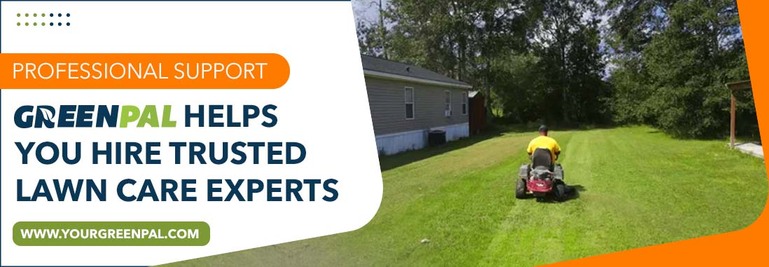What is yard grading? Homeowners share thoughts on hiring a pro
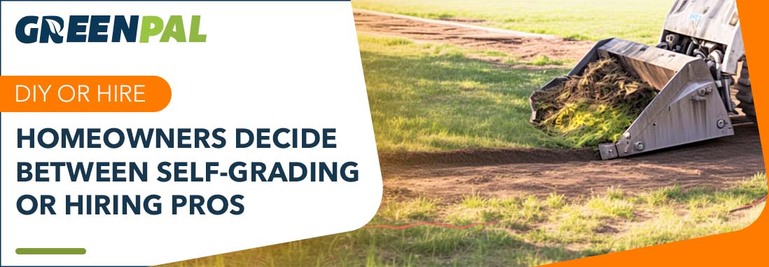
What happens to your lawn when it rains? Does the water drain well? If not, you may need to consider grading your yard. A well-graded yard provides the foundation for a healthy lawn.
We asked 190 homeowners needing yard grading whether they would do it themselves or hire a professional and had them list why they chose one or the other.
Survey Results
Hire a professional: 157 |
Do it myself: 33 |
Trust a professional more: 80 |
Small project: 25 |
Large project/save time: 42 |
Have skills/equipment: 8 |
Don't have equipment: 3 |
- |
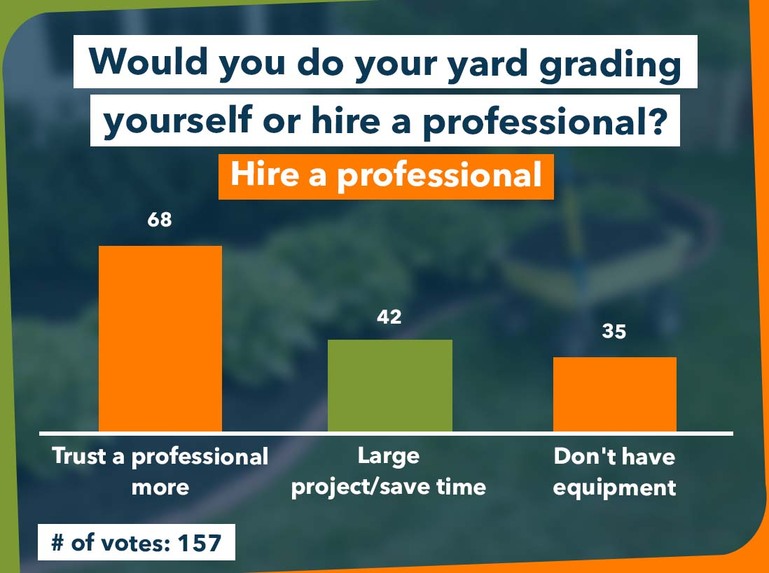
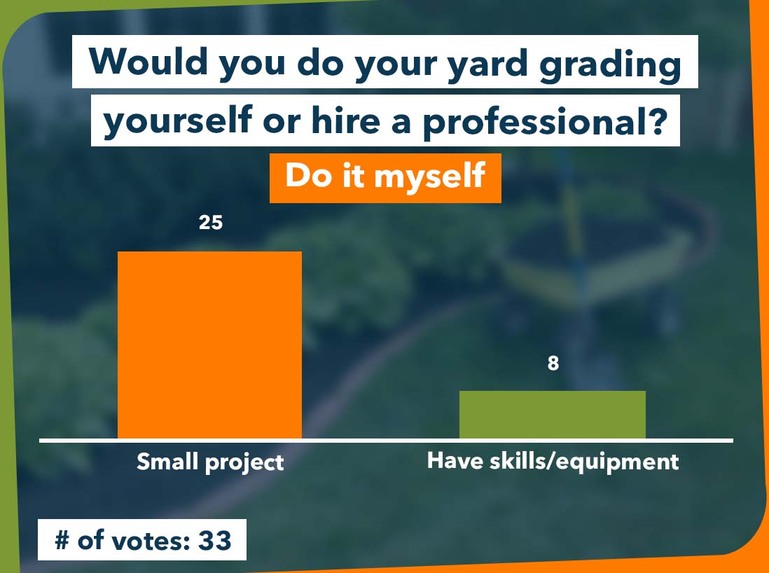
What is yard grading?
The goal of yard grading is establishing a desired slope for water drainage around your home. Without this drainage, you may face foundation issues and other water damage.
Improving the slope of the land not only helps with drainage but also readies it for any upcoming landscaping tasks, such as laying down grass sod or creating gardens and hardscaping features like patios or driveways. If the grading is not done correctly, you could encounter problems like standing puddles of water, soil erosion, or an uneven yard.
The importance of yard grading
Proper yard grading is crucial in maintaining your lawn — and your property, too. When done right, grading ensures water moves away from your house instead of collecting near the foundation or low areas in your lawn.
Plants die when overwatered. Yard grading helps. Fungi thrive in wet conditions, and lawn diseases need moisture to do their worst.
This excess water can cause other problems:
Unregulated water movement can result in soil erosion, which may wash away the topsoil, causing areas and a lawn that looks unappealing and unhealthy.
When there is drainage near your home, water may collect close by. That might result in your basement or crawl space being flooded.
Root rot or suffocating trees, plants, and bushes can happen with standing water.
If you live in an area with harsh winters, you may face extra ice buildup during a freeze.
When you mow, you may cause ruts.
Ensuring your lawn has the right slope can help avoid these issues and improve the well-being and durability of your home and yard.
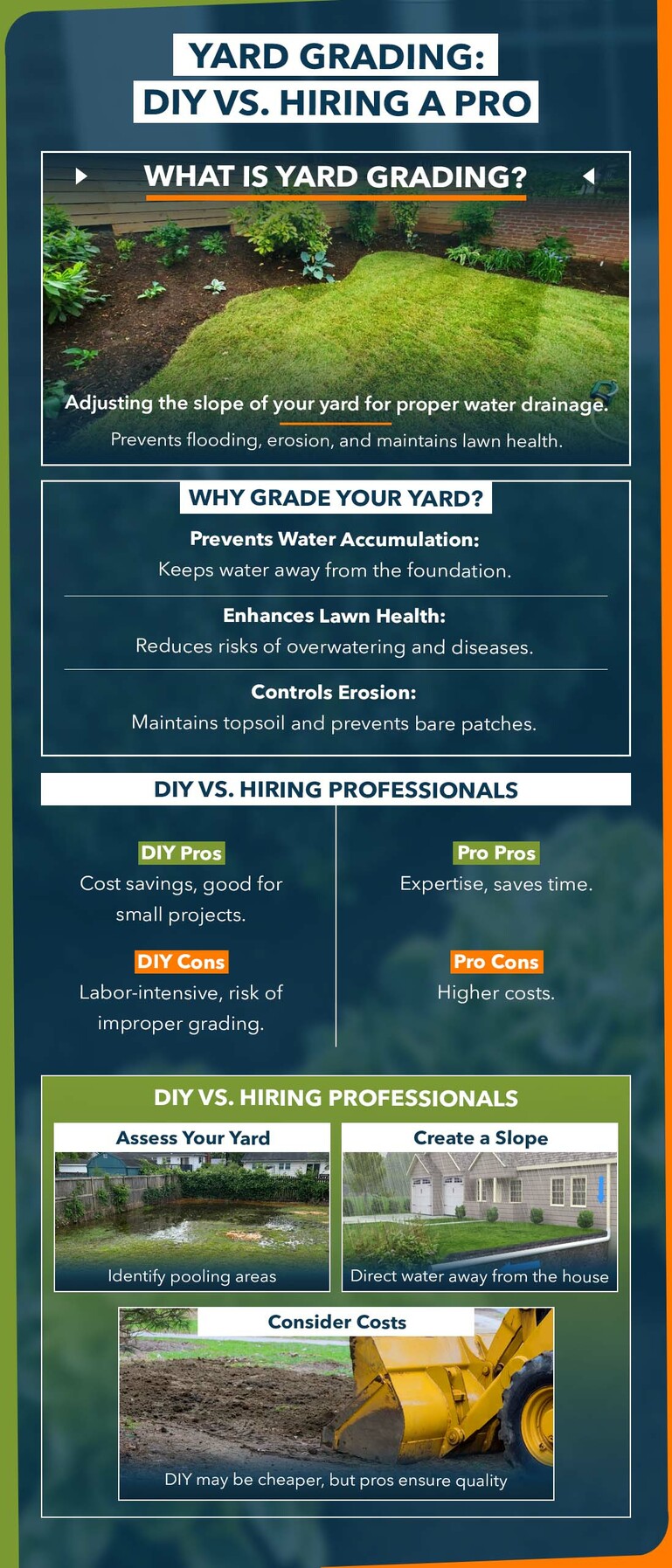
DIY Yard Grading vs. Hiring Professionals
A majority of homeowners seek to hire a professional
For many homeowners in our survey (83%), yard grading is easily understood, but to get their lawn back to where it should be, doing it themselves was usually too tall of a task.
Some respondents who went the DIY route only needed minor work, but for others, the amount of work it would take to grade their yard required heavy equipment, including loaders.
They hired a finish grader because ensuring their home's foundation was protected was worth the investment.
Pros and Cons of DIY Yard Grading
Pros |
Cons |
Cost savings on labor |
Labor-intensive and requires specific tools |
Ideal for small-scale projects |
Risk of improper grading, leading to drainage issues |
- |
Difficult to achieve professional results without experience |
Yard Grading for Drainage Issues
Grading your yard properly is a way to effectively address drainage issues in your property and prevent problems, like standing water and soil erosion, that can harm your home's foundation over time.
If rainstorms leave your yard with puddles of water or cause water to move toward your house, grading can help solve the problem effectively. With grading, you can adjust the landscape to guide water flow towards drainage spots, like storm drains, swales, or other planned drainage systems.
Proper grading also helps prevent erosion and safeguards your lawns and garden beds, enabling grass and plants to flourish without being swept away in intense rainy weather.
Have you been bitten by a mosquito sitting out on your porch lately? If you have a drainage issue, you may invite tons of these pests to your lawn.
RELATED: Mow Your Lawn to Fight Against the Zika Virus
Yard drainage can also help with underground water issues caused by soil that doesn't drain well and gets soaked during heavy rainstorms.
Adjusting the yard's slope to create an incline that diverts water away from the foundation can be beneficial in stopping additional water seepage and safeguarding the structural integrity of your home.
Addressing Drainage Issues Through Grading

When addressing drainage issues on your property, the key is to create a slope that directs water away from vulnerable areas that could lead to potential harm.
This basic adjustment can help prevent water accumulation near your home base or in areas to safeguard both your property and surrounding landscape from water-related harm.
The grading process starts by examining your yard's existing layout, where a skilled landscaper or grading expert will evaluate the incline and locate spots where water pools up frequently. They will then employ tools such as laser levels and surveying gear to determine the precise slope required for effective water drainage.
RELATED: Sustainable Lawn Irrigation: Tips for Saving Water (and Money)
Finish graders and contractors commonly combine grading the yard to create a slope with installing additional drainage systems for effective moisture management on the property premises. For instance, French drains are often added in to provide additional help.
To further enhance drainage efficacy and erosion prevention, swales — grassy ditches designed to redirect flowing water — are strategically implemented. The combination of these elements works well with the graded landscape, ensuring that water flows off the property smoothly during heavy rainfall without causing any harm or disruption.
Maintaining grading also helps prevent soil erosion by controlling water flow across your lawn to avoid washing away topsoil or creating bare patches in your yard. It is essential to direct water to minimize these risks. Once the grading work is finished, reseeding the lawn or installing sod can further stabilize the soil.
Costs of Lawn Grading
Maintaining your yard can require a financial commitment; however, the benefits include safeguarding your property and enhancing its visual appeal. Many factors, like the size of your yard, the incline, and soil quality, can influence costs.
DIY projects tend to run around a few hundred dollars to get the dirt, the string, and the tools needed to grade the yard.
Expect to pay within a range of $1000 to $3000. For bigger or more intricate projects, the expenses can go up to $5000 or higher, covering labor costs and the materials and equipment needed.
RELATED: Survey: 305 homeowners share how often they water their lawn
Larger yards demand more effort in terms of maintenance — more soil and time investment ultimately lead to higher expenses. Depending on the steepness of the slope, the project may require soil and labor, especially for extreme grading requirements.
Grading can be more challenging when dealing with hard and compacted soil. Challenges such as trees or large rocks can make leveling the ground more difficult in the area. All of these factors may lead to higher labor expenses.
Experienced contractors usually charge from $50 to $200 per hour for their services based on where you are located.
Frequently Asked Questions

How much time does it usually take to finish grading a yard?
Grading a home garden usually requires about 1 to 3 days to complete based on the intricacy of the project.
Should I grade my yard or hire a professional?
When dealing with projects or minor concerns in your yard, grading work can be a DIY option; however, if you have a larger yard or face significant drainage issues, hiring a professional is best.
What is the difference between leveling and grading?
Land grading shapes the land to create slopes so water drains away from your home. Land leveling creates an even plane.
How can I keep my lawn in shape after grading it?
Following grading the land surface for landscaping purposes or construction projects, it is crucial to consider reseeding or laying down sod to prevent soil erosion effectively and maintain the integrity of the landscape over time.
It is also a good idea to keep an eye on the drainage systems to verify that the slope is functioning efficiently and remains conducive to preventing erosion in the long run.
Quick Summary
Decision |
Count |
Reasons for Choice |
Hire a Professional |
157 |
Trust expertise (80), large project/save time (42) |
Do It Myself |
33 |
Small project (25), skills/equipment (8) |
Trust a Professional More |
80 |
Concern for proper grading and drainage |
Have Skills/Equipment |
8 |
Confidence in DIY projects |
Don’t Have Equipment |
3 |
Lack of necessary tools for grading |
Yard grading helps resolve drainage issues in lawns. This process is important to keep a home's foundation in good shape.
We asked 190 homeowners who potentially need yard grading whether they were going to do it themselves or hire a professional.
The majority of respondents said they were planning to work with a professional.





 Share
Share




